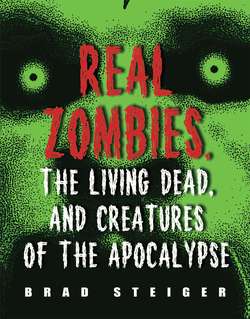Читать книгу Real Zombies, the Living Dead, and Creatures of the Apocalypse - Brad Steiger - Страница 48
На сайте Литреса книга снята с продажи.
The Ancient Religion of Voodoo
ОглавлениеAccording to some of its more passionate adherents, Vodun/Vodoun is not a magical tradition, not an animistic tradition, not a spiritistic tradition—neither should it be a pagan religion. The deities of Voodoo are not simply spiritual energies and the path of Voodoo should not be followed for the sake of power over another. Although the Voodoo religion does not demand members proselytize, anyone may join. However, 99 percent of its priesthoods are passed from generation to generation.
The same individuals who esteem their Voodoo religion so highly, insist that it is neither dogmatic nor apocalyptic. Whatever outsiders may make of their faith, the sincere Voodoo follower declares that it has no apocalyptic tradition that prophesizes a doomsday or end-of-the-world scenario.
Although one might suspect that these same true believers are a bit dogmatic when they emphasize that Voodoo was not created as a result of captive West Africans being transported to Roman Catholic countries as slaves, a closer look reveals that Voodoo is not really a blend of African religions and Catholicism, but a clever mask that disguised the ancient deities of the Old Religion.
One point the believers in Voodoo make that cannot be disputed is that the religion did not originate in Haiti. Vodun/Voodoo definitely emerged out of Africa.
Voodoo means “spirit” in the language of the West African Yoruba, and the religion is an assortment of African beliefs and rites that may go back as many as 6,000 to 10,000 years. Slaves, who were snatched from their homes and families on Africa’s West Coast, brought their gods with them. Plantation owners in Haiti and other West Indian islands purchased the slaves for rigorous labor and had no interest in their religious beliefs—if they even had any at all. In the minds of their owners, the African slaves were simple savages from the jungle who probably were not even at the level of a culture in which a kind of worship of God would even be comprehended.
Some traditional Voodoo Priests and Priestesses will sew closed the eyes and the mouth of the zombie whom they have enslaved (art by Ricardo Pustanio).
In spite of their indifference to any possible theologies that their slaves might hold, the plantation owners in Haiti were compelled by order of the lieutenant-general to baptize them in the Catholic religion. The slaves were in no position to protest their forced conversion, but by the time the West Africans submitted to mass baptism, the wise priests among them had already discovered simple segues from worshipping the old jungle family of gods and goddesses into bowing and praying to their newly acquired Catholic saints.
As the black population increased and the white demand for slave labor was unceasing, vodun began to take on an anti-white liturgy. Several “messiahs” emerged among the slaves, who were subsequently put to death by the whites in the “big houses.” A number of laws began to be passed forbidding any plantation owner to allow “night dances” among his negroes.
In 1791, a slave revolt took place under the leadership of Toussaint L’Ouverture which was to lead to Haiti’s independence from France in 1804. Although L’Ouverture died in a Napoleonic prison, his generals had become sufficiently inspired by his example to continue the struggle for freedom until the myth of white supremacy was banished from the island.
After the Concordat of 1860, when relations were reestablished with France, the clergy fulminated against vodun from the pulpits but did not actively campaign against their rival priesthood until 1896 when an impatient monsignor tried without success to organize an anti-vodun league. It wasn’t until 1940 that the Catholic church launched a violent campaign of renunciation directed at the adherents of vodun. The priests went about their methodic attack with such zeal that the government was forced to intercede and command them to temper the fires of their campaign.
Today there are over 80 million people who practice vodun worldwide, largely where Haitian emigrants have settled: Benin, Dominican Republic, Ghana, Togo, various cities in the United States (primarily New Orleans), and, of course, Haiti. In South America, there are many religions similar to vodun, such as Umbanda, Quimbanda, or Candomblé.
